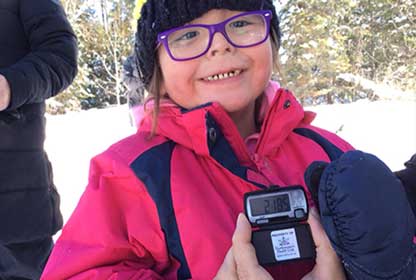How Many Steps to the Outdoor
Early Years (Age 3 – 6)
Curriculum Goal
Kindergarten – Measurement and Counting
- 2.2: Demonstrate a willingness to try new experiences and to adapt to new situations (SRWB)
- 16.2: Investigate strategies and materials used when measuring with non-standard units of measure (DLMB)
Context
- Students quantify distance by walking along a pathway from one location to another wearing pedometers.
Materials
- Pedometers
- Papers
- Pencils
Lesson
Introduction
- Explain that a pedometer is like a step-counter that tracks how many steps you take when you walk from one place to another.
- Have students predict the number of steps they think it will take to get from one spot to the outdoor classroom (or another location).
- Have the students (or yourself) note the number down on their piece of paper.
Lesson
- Students will wear the pedometer and walk the predetermined path. At the end of the walk, instruct students to pay attention to the number of steps they have walked and note it down next to their prediction.
- Lead a discussion about the students’ predictions versus the actual number of steps walk.
- How many students predicted they would take more steps than they did?
- How many students predicted they would take fewer steps than they did?
- Use a bar graph to depict students’ predictions compared to the actual number of steps required to get to the outdoor classroom.
Closure
- Encourage students to think about the step as a non-standard unit of measurement.
- Is student A’s step the same as student B’s step?
- Discuss why the number of steps to get from one spot to another was different for each student.
- Each student has a different stride, pace, etc.
- Determine whether the class can we classify the students into groups based on height or some other characteristic that seem to correlate with the number of steps taken to the outdoor classroom?
- Discuss other non-standard units of measurement that may be more accurate than steps.

Look Fors
- Are students able compare their predictions to their final measurements of steps?
- Can students understand the concept of a non-standard unit of measurement? Are they able to come up with other examples of units that could be used?
- Are students able to identify why their individual characteristics (stride, pace, etc.) would lead to differing step totals between classmates?
Share this lesson
Share on facebook
Share on twitter
Share on email
